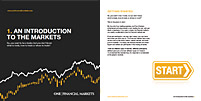

Long-term investing framework: Are you a balanced bear? Goldman Sachs weighs in
Amidst market volatility and economic uncertainty, Goldman Sachs has offered a fresh perspective with its "Strategic Balanced Bear" investing framework note on Monday.
This approach aims to guide investors through the complexities of long-term investing, helping them navigate periods of downturn while positioning themselves for future growth.
What is the 60-40 Rule?
In the note, analysts at the investment bank note that 60/40 portfolios have mostly recovered from the large drawdown in 2022.
According to the Goldman Sachs asset management site itself, the firm notes the 60/40 portfolio “has long been revered as a trusty guidepost for a moderate risk investor.”
A 60/40 portfolio involves an investor holding a 60% allocation to equities, aiming to achieve capital appreciation. Meanwhile, the investor has a 40% allocation to fixed income, potentially offering income and risk mitigation.
Goldman Sachs Market Analysis June 2024
The investment bank believes 60/40 valuations look again somewhat elevated.
“US 10-year bond yields are closer to the long-run average, but equity valuations are relatively elevated, especially in the US,” they write. However, it is felt that valuations alone may send too bearish of a signal.
Goldman Sachs explains that over long horizons, valuations tend to mean-revert, but they can remain elevated as long as macro conditions remain supportive.
“Both 60/40 returns and realised equity risk premia in the coming years will not just depend on valuations but also on the structural cycle, i.e., trends in growth, inflation and policy,” they add.
Furthermore, in the coming years Goldman Sachs sees value in being more balanced again. They also highlight that the outlook for the structural cycle has become more uncertain, with ongoing deglobalisation, decarbonisation and demographic trends that could result in more inflation pressures.
Meanwhile, technological innovations such as AI and GLP-1 could counter them and boost growth, says the bank.
“Equities could provide some inflation protection via cash flow growth, but valuations are elevated, with little risk of inflation or stagnation priced,” comments Goldman Sachs. “Real assets, such as TIPS, commodities, real asset stocks, and those exposed to productivity growth, e.g., growth stocks, can further enhance diversification.”
Overall, they feel that while real assets currently look cheap, growth stocks look expensive.
Are Bonds A Good Investment Now?
When it comes to bonds, Goldman says that with solid growth and little inflation in the last 25 years, the optimal asset mix was roughly 40/60, closer to a risk parity strategy. However, “since the COVID-19 crisis, bonds have offered little benefit to portfolios, either on return or risk,” with the optimal portfolio since then being mixing 100% equities with cash based on risk tolerance.
Nevertheless, the bank says bonds can provide protection in the event of stagnation with higher real yields, but they note that they are pricing low inflation risk.
Long-Term Investing: Is Cautious or Aggressive Best?
When developing its model for long-term 60/40 returns, Goldman Sachs says it assessed factors such as starting valuations, together with inputs on trend growth, inflation and profitability, to control for different structural cycle scenarios, such as Stagflation and Goldilocks.
They feel that long-term equity and bond performance is conditioned by the structural growth/inflation mix.
“High inflation tends to weigh on both equity and bond returns, especially in real terms, even though equity risk premia tend to be average. Higher growth is unsurprisingly good for equities and bad for bonds,” explains Goldman.
When assessing equity and bond returns, structural macro conditions “matter critically,” and investors should consider using a “building block approach” combining both valuations and macro conditions.
Recession-Proof Stocks That Offer Drawdown Safety
By diversifying portfolios with recession-resistant stocks, investors can mitigate risk and maintain consistent returns, even in turbulent markets. While sectors like healthcare and consumer staples are renowned for their resilience, other stock sectors may experience volatility due to industry-specific challenges.
Begin trading today! Create an account by completing our form
Privacy Notice
At One Financial Markets we are committed to safeguarding your privacy.
Please see our Privacy Policy for details about what information is collected from you and why it is collected. We do not sell your information or use it other than as described in the Policy.
Please note that it is in our legitimate business interest to send you certain marketing emails from time to time. However, if you would prefer not to receive these you can opt-out by ticking the box below.
Alternatively, you can use the unsubscribe link at the bottom of the Demo account confirmation email or any subsequent emails we send.
By completing the form and downloading the platform you agree with the use of your personal information as detailed in the Policy.






